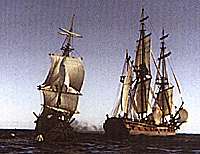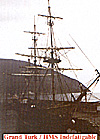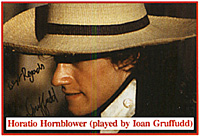On A Mission
with 'Horatio Hornblower, RN'
by Richard Rutherford-Moore
| |
Avast, ship-shape, Bristol-fashion, belay ... and all the rest of that nautical terminology oft heard by 'pirates' returning 'awash' from the beer tent at night on a campsite took on a whole new meaning when I threw in my lot with 'Hornblower'. After two years of planning, the production got 'under way' in September 1997 and 'under topsails' at first slowly began the laborious process of bringing another fictional - and enduring - popular hero to the small screen. Wargamers would have loved it - or maybe not. A whole fleet of warships and transports were assembled under the watchful eye of the model-making supervisor Martin Saville ; and all required the sort of detail known only to those of us who in past years have spent many myopic hours ruining our eyesight under the glare of a table lamp, tiny paint brush in hand, creating armies of 15mm lead soldiers (25mm was bad enough). Each ship model was the size of a small truck (with little scale clockwork sailormen who misbehaved so much they all eventually got a fresh posting - to Davy Jones' Locker from the producer) and with enough scaled-down rigging and cordage to make you cross-eyed They looked splendid in the water-tank though, under the effects of the wind machine and wave-maker, their little cannons popping off at each other across six feet of starched 'seawater' (a Russian error - it wasn't done to eliminate errant wavelets - they thought the water wasn't blue enough). That was in the early days - for those having the good sense to use the models to find out what a bitt or a backstay really was, the arrival of the real things were a little less daunting. By Toutatis - when a full size British Napoleonic frigate under full sail rounds the headland and starts firing cannons it makes a true Englishman's heart swell with pride. But - to enjoy it you first have to create it. The Grand Turk
There was some sea-sickness early on. Julia was a topsail schooner and a heavy ship to boot, and in the open sea you felt every lurch and dip. All the first scenes at sea were shot on Julia. The Black Sea was kind at first, allowing each a taste of what it could do when the worst of it came we were all prepared for it in the stomach department, at least. I trained a basic group of twelve Royal Marines, picked from the two hundred volunteers who answered the 'handbills' posted up in Yalta. The rest were listed as ships' crew; their first job was to learn how to load and handle cannons on the training deck at Yalta Studios. We took it a step at a time (in the back of my mind were echoes of the terrible accidents in re-enactment using artillery). Each man had a good understanding of them before we went onto more specific actions - over two weeks we became pretty proficient at it. For a break, we all poured onto an unused film set next door from last years' film Marco Polo and learned how to rummage all over it kicking doors in, breaking furniture and swinging from roof and window whilst fighting in hand-to-hand combat with cutlass and musket - several budding Errol Flynn's manifested themselves ! It was good practice for when we eventually moved on board ship - although the Marines still had their shakoes knocked off by rigging and seamen still tripped over ringbolts set into the gundeck for a while (in your bare feet, it don't 'arf hurt - but, blaspheming on camera is in character as long as it is English, not in Russian!). Most of the seafaring scenes originated from Artek harbour, ten miles up the coast. We all transferred there later and were fitted for uniform and costume under the watchful eyes of John Mollo and Gordon Harmer; the harbour on a typical training day grew picturesque, with seamen and marines rollicking about, boarding and rowing boats, practising gun drill on ship, agile 'topmen' fitting vessels out and throwing stones at clouds jellyfish - the harbour was a favoured breeding ground for them and any false slip into the water there rendered you coming out looking like a refugee from The Revenge of the Killer Tomatoes for days afterwards. Midships The enormous three hundred ton floating 'pontoon' from Sevastopol which was done out as the midships section of a third-rate warship (complete with two gundecks, cabins, gunroom and wardroom) sprouted small improvised signs on the overhead beams saying MIND YOUR HEAD as many an unwary brow got the 'pontoon tattoo' embossed on it some crewmen after a long spell on board walked about even on dry land with a permanent stoop with their arms hanging down to their knees making them look like pigtailed chimpanzees. HMS (Historic Maritime Society) courtesy of that old sea dog Chris Jones sent in a sample of their 'seaman's dictionary' for us. After working my way through that, I then felt confident to take on jobs like reefing, handing, steering and splicing - I then worked my way up through navigation by 'dead-reckoning'; always handy if you need to know where you should be rather than where you actually are! Grand Turk's crew were always helpful in explaining the finer points of seamanship as if they'd done it for years (which of course they had - you never caught them spitting, even to leeward). You get a good insight into what it must have been like by simply lending a hand hauling on braces. hoisting yards, taking in reefs, sheeting home mainsails or weighing anchor - and running out the 'great guns' on the weather quarter, with the deck at around ten degrees from horizontal. It's all very physical, but builds the kind of body that you'd pay a gym or nature farm a fortune to help you attain.
At right, Ioan Gruffudd plays Horation Hornblower. The true misery of being at sea is on deck on duty on a rotten wet day with a malicious north wind blowing ; if you are unlucky enough to have to sit in an open boat at night with your feet in slopping sea water for hours because of a lost baler, it can be enough to break your heart looking through a telescope where you can just make out a small crowd lurking under a cloud of cigarette smoke by the tea-urns about 500 metres away on dry land, but as accessible to you as if they were on the moon. You either become an 'iron man' in a 'wooden ship', become 'DD' - or stay at home in front of the fire. We did have one sticky situation one night as some of you read about in the newspapers. The ships' officers handled the crisis extremely well and we all got off the ship without serious injury or damage. It was a titanic 'night to remember' - one I'll remember for a long time (I only have to look in the mirror and see the grey hairs). As on previews escapades, many thanks to those FE readers who wrote to me abroad - I hope to see you again soon. Enjoy 'Hornblower' on the telly - and spare a thought and a tot of rum for those poor devils who overcame great privations and logistical nightmares to put it there! MR MIDSHIPMAN HORNBLOWER; the first two episodes in 1997 were 'The Even Chance' and 'The Examination for Lieutenant' - followed by 'Frogs and Lobsters' and 'The Duchess and the Devil' going In Production on location in 1998; all produced for MERIDIAN TELEVISION. HMS can be contacted through Chris Jones at 75337.1362@compuserve.com or the author of the article at r@armor.demon.co.uk Back to Table of Contents -- First Empire #40 Back to First Empire List of Issues Back to MagWeb Master Magazine List © Copyright 1998 by First Empire. This article appears in MagWeb (Magazine Web) on the Internet World Wide Web. Other military history articles and gaming articles are available at http://www.magweb.com |
 Following requests from readers, FE's 'roving' correspondent Richard Rutherford-Moore sends in a short report on what it was like afloat for three months on the Black Sea filming the first two episodes in the television series HORNBLOWER.
Following requests from readers, FE's 'roving' correspondent Richard Rutherford-Moore sends in a short report on what it was like afloat for three months on the Black Sea filming the first two episodes in the television series HORNBLOWER.
 Grand Turk was built in the Sea of Marmora (Turkey) under the ownership of Mr Michael Turk, a Thames Royal Waterman of HM Queen, under the auspices of his shipwright Mr Ian MacDougall. She was laid down as a sixth-rate, three-masted square rigged vessel in an original form, and sailed across the Black Sea to join us on her maiden voyage. Before she could, the crew and the Art Department had to transform her into HMS Indefatigable of the Napoleonic Royal Navy ;ten days to fit the sails, paint the hull, take onboard her cannon armament and set up all the running rigging, and lash it all down. Space on board was at a premium already for gear and equipment - what it was like with a fifty-person film crew and two hundred extras on board too all armed to the teeth you can well imagine. Add an inky black night and a deep ocean swell with the ship at sea and you have a recipe for potential disaster or some excellent footage for your film. We had both.
Grand Turk was built in the Sea of Marmora (Turkey) under the ownership of Mr Michael Turk, a Thames Royal Waterman of HM Queen, under the auspices of his shipwright Mr Ian MacDougall. She was laid down as a sixth-rate, three-masted square rigged vessel in an original form, and sailed across the Black Sea to join us on her maiden voyage. Before she could, the crew and the Art Department had to transform her into HMS Indefatigable of the Napoleonic Royal Navy ;ten days to fit the sails, paint the hull, take onboard her cannon armament and set up all the running rigging, and lash it all down. Space on board was at a premium already for gear and equipment - what it was like with a fifty-person film crew and two hundred extras on board too all armed to the teeth you can well imagine. Add an inky black night and a deep ocean swell with the ship at sea and you have a recipe for potential disaster or some excellent footage for your film. We had both.
